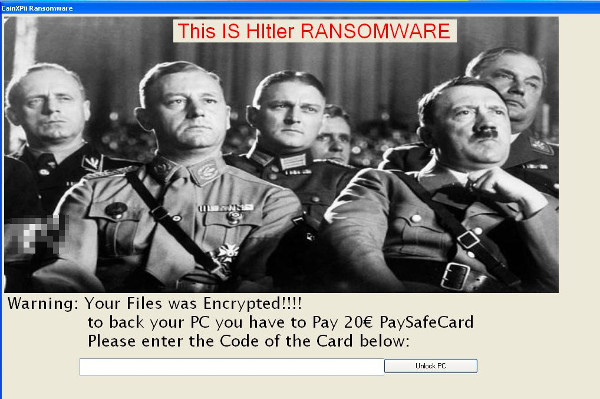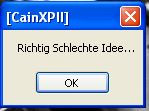RANSOM_LERITH.C
Ransomer.LZB (AVG), Ransom.Hitl (Malwarebytes)
Windows


Threat Type: Trojan
Destructiveness: No
Encrypted: No
In the wild: Yes
TECHNICAL DETAILS
84,992 bytes
EXE
Yes
30 Sep 2016
encrypts files, renames encrypted files, Drops files
Other System Modifications
This Trojan adds the following registry keys:
HKLM\SOFTWARE\Classes\
.exe
HKLM\SOFTWARE\Classes\
exe\shell\open\
command
HKLM\SOFTWARE\Classes\
.dll
HKLM\SOFTWARE\Classes\
dll\shell\open\
command
HKLM\SOFTWARE\Classes\
.mp3
HKLM\SOFTWARE\Classes\
mp3\shell\open\
command
HKLM\SOFTWARE\Classes\
.mp4
HKLM\SOFTWARE\Classes\
mp4\shell\open\
command
HKLM\SOFTWARE\Classes\
.reg
HKLM\SOFTWARE\Classes\
reg\shell\open\
command
HKLM\SOFTWARE\Classes\
.bat
HKLM\SOFTWARE\Classes\
bat\shell\open\
command
HKLM\SOFTWARE\Classes\
.vbs
HKLM\SOFTWARE\Classes\
VBS\shell\open\
command
HKLM\SOFTWARE\Classes\
.cmd
HKLM\SOFTWARE\Classes\
cmd\shell\open\
command
HKLM\SOFTWARE\Classes\
.png
HKLM\SOFTWARE\Classes\
png\shell\open\
command
HKLM\SOFTWARE\Classes\
.jpg
HKLM\SOFTWARE\Classes\
jpg\shell\open\
command
HKLM\SOFTWARE\Classes\
.jpeg
HKLM\SOFTWARE\Classes\
jpeg\shell\open\
command
HKLM\SOFTWARE\Classes\
.lnk
HKLM\SOFTWARE\Classes\
lnk\shell\open\
command
It adds the following registry entries:
HKLM\SOFTWARE\Classes\
exe\shell\open\
command
(Default) = {malware path}\{malware file name}.exe "%1"
HKLM\SOFTWARE\Classes\
dll\shell\open\
command
(Default) = {malware path}\{malware name}.exe "%1"
HKLM\SOFTWARE\Classes\
mp3\shell\open\
command
(Default) = {malware path}\{malware name}.exe "%1"
HKLM\SOFTWARE\Classes\
mp4\shell\open\
command
(Default) = {malware path}\{malware name}.exe "%1"
HKLM\SOFTWARE\Classes\
reg\shell\open\
command
(Default) = {malware path}\{malware name}.exe "%1"
HKLM\SOFTWARE\Classes\
bat\shell\open\
command
(Default) = {malware path}\{malware name}.exe "%1"
HKLM\SOFTWARE\Classes\
VBS\shell\open\
command
(Default) = {malware path}\{malware name}.exe "%1"
HKLM\SOFTWARE\Classes\
cmd\shell\open\
command
(Default) = {malware path}\{malware name}.exe "%1"
HKLM\SOFTWARE\Classes\
png\shell\open\
command
(Default) = {malware path}\{malware name}.exe "%1"
HKLM\SOFTWARE\Classes\
jpg\shell\open\
command
(Default) = {malware path}\{malware file name}.exe "%1"
HKLM\SOFTWARE\Classes\
jpeg\shell\open\
command
(Default) = {malware path}\{malware name}.exe "%1"
HKLM\SOFTWARE\Classes\
lnk\shell\open\
command
(Default) = {malware path}\{malware name}.exe "%1"
HKLM\SOFTWARE\Classes\
.exe
(Default) = exe
HKLM\SOFTWARE\Classes\
.dll
(Default) = dll
HKLM\SOFTWARE\Classes\
.mp3
(Default) = mp3
HKLM\SOFTWARE\Classes\
.mp4
(Default) = mp4
HKLM\SOFTWARE\Classes\
.reg
(Default) = reg
HKLM\SOFTWARE\Classes\
.bat
(Default) = bat
HKLM\SOFTWARE\Classes\
.vbs
(Default) = vbs
HKLM\SOFTWARE\Classes\
.cmd
(Default) = cmd
HKLM\SOFTWARE\Classes\
.png
(Default) = png
HKLM\SOFTWARE\Classes\
.jpg
(Default) = jpg
HKLM\SOFTWARE\Classes\
.jpeg
(Default) = jpeg
HKLM\SOFTWARE\Classes\
.lnk
(Default) = lnk
Other Details
This Trojan renames encrypted files using the following names:
- %Desktop%\Hitler Ransomware_{Number of files encrypted}.CainXPii
(Note: %Desktop% is the desktop folder, where it usually is C:\Documents and Settings\{user name}\Desktop in Windows 2000, Windows Server 2003, and Windows XP (32- and 64-bit); C:\Users\{user name}\Desktop in Windows Vista (32- and 64-bit), Windows 7 (32- and 64-bit), Windows 8 (32- and 64-bit), Windows 8.1 (32- and 64-bit), Windows Server 2008, and Windows Server 2012.)
NOTES:
The ransomware encrypts all files located in %Desktop%.
When the ransomware encrypts all files, the following window containing the ransom note is displayed:

If the user clicks the "Unlock PC" button, it connects to the smtp client smtp.{BLOCKED}l.com
It uses the following credentials:
The ransomware then sends out an e-mail with the following details:
If the user tries to close the window, it displays the following message box:

SOLUTION
9.800
12.812.04
01 Oct 2016
12.813.00
02 Oct 2016
Step 1
Before doing any scans, Windows XP, Windows Vista, and Windows 7 users must disable System Restore to allow full scanning of their computers.
Step 2
Note that not all files, folders, and registry keys and entries are installed on your computer during this malware's/spyware's/grayware's execution. This may be due to incomplete installation or other operating system conditions. If you do not find the same files/folders/registry information, please proceed to the next step.
Step 3
Restart in Safe Mode
Step 4
Delete this registry key
Important: Editing the Windows Registry incorrectly can lead to irreversible system malfunction. Please do this step only if you know how or you can ask assistance from your system administrator. Else, check this Microsoft article first before modifying your computer's registry.
- In HKEY_LOCAL_MACHINE\SOFTWARE\Classes
- .exe
- .exe
- In HKEY_LOCAL_MACHINE\SOFTWARE\Classes\exe\shell\open
- command
- command
- In HKEY_LOCAL_MACHINE\SOFTWARE\Classes
- .dll
- .dll
- In HKEY_LOCAL_MACHINE\SOFTWARE\Classes\dll\shell\open
- command
- command
- In HKEY_LOCAL_MACHINE\SOFTWARE\Classes
- .mp3
- .mp3
- In HKEY_LOCAL_MACHINE\SOFTWARE\Classes\mp3\shell\open
- command
- command
- In HKEY_LOCAL_MACHINE\SOFTWARE\Classes
- .mp4
- .mp4
- In HKEY_LOCAL_MACHINE\SOFTWARE\Classes\mp4\shell\open
- command
- command
- In HKEY_LOCAL_MACHINE\SOFTWARE\Classes
- .reg
- .reg
- In HKEY_LOCAL_MACHINE\SOFTWARE\Classes\reg\shell\open
- command
- command
- In HKEY_LOCAL_MACHINE\SOFTWARE\Classes
- .bat
- .bat
- In HKEY_LOCAL_MACHINE\SOFTWARE\Classes\bat\shell\open
- command
- command
- In HKEY_LOCAL_MACHINE\SOFTWARE\Classes
- vbs
- vbs
- In HKEY_LOCAL_MACHINE\SOFTWARE\Classes\VBS\shell\open
- command
- command
- In HKEY_LOCAL_MACHINE\SOFTWARE\Classes
- .cmd
- .cmd
- In HKEY_LOCAL_MACHINE\SOFTWARE\Classes\cmd\shell\open
- command
- command
- In HKEY_LOCAL_MACHINE\SOFTWARE\Classes
- .png
- .png
- In HKEY_LOCAL_MACHINE\SOFTWARE\Classes\png\shell\open
- command
- command
- In HKEY_LOCAL_MACHINE\SOFTWARE\Classes
- .jpg
- .jpg
- In HKEY_LOCAL_MACHINE\SOFTWARE\Classes\jpg\shell\open
- command
- command
- In HKEY_LOCAL_MACHINE\SOFTWARE\Classes
- .jpeg
- .jpeg
- In HKEY_LOCAL_MACHINE\SOFTWARE\Classes\jpeg\shell\open
- command
- command
- In HKEY_LOCAL_MACHINE\SOFTWARE\Classes
- .lnk
- .lnk
- In HKEY_LOCAL_MACHINE\SOFTWARE\Classes\lnk\shell\open
- command
- command
Step 5
Restart in normal mode and scan your computer with your Trend Micro product for files detected as RANSOM_LERITH.C. If the detected files have already been cleaned, deleted, or quarantined by your Trend Micro product, no further step is required. You may opt to simply delete the quarantined files. Please check this Knowledge Base page for more information.
Step 6
Restore encrypted files from backup.
Did this description help? Tell us how we did.

